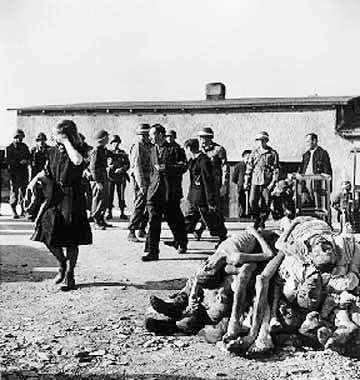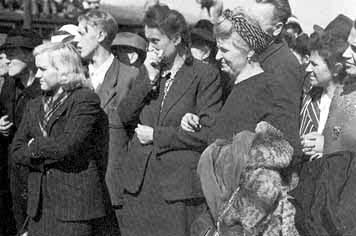Green Energy
- That's One Way To Make Health Care Reform Look Like A Snap
Politico: A day after his big Cairo speech, President Obama is saying 'the moment is now' for action on Mideast peace. 'I am confident that if we stick with it, having started early, we can make some serious progress this year,'...
- Obama To Trace Family History In Germany
Spiegel's take on the Dresden visit Pastorius posts about a bit below. This article is from May 6 so things may have changed. Or it's possible Spiegel is spinning. Or the American Thinker/Free Republic piece hyperventilating. But according to...
- One Helluva Message In The Bottle
from ABC: Workers find message hidden in Auschwitz wall Posted Tue Apr 28, 2009 5:11am AEST Workers demolishing the wall of a building that once belonged to the former Nazi German Auschwitz-Birkenau death camp have found a message in a bottle written...
- Is It Really That Easy To Slide From Nazi To Muslim? Even I Have A Hard Time With It
Fugitive Nazi lived as 'pious Muslim' at Cairo hotel One of the most wanted Nazi war criminals, Aribert Heim or "Doctor Death," lived for years as a quiet, pious Muslim in a small hotel on the edge of Islamic Cairo, where he was known as Doctor...
- Today (in 1945)
The liberation of Auschwitz: Soon after liberation, surviving children of the Auschwitz camp walk out of the children's barracks. Poland, after January 27, 1945. From the web site of The United States Holocaust Memorial Museum: Auschwitz was the...
Green Energy
Today in 1945 …NEVER FORGET WHAT DOING NOTHING BECAUSE EVIL IS TOO HARD TO BELIEVE CAN DO
From Scrapbookpages
German civilians tour Buchenwald Camp
Weimar residents forced to look at rotting corpsesAfter the Buchenwald concentration camp was liberated on April 11, 1945, the political prisoners in the camp set up a tour of exhibits. On April 15, 1945, the German civilians from the nearby town of Weimar were brought to see the evidence of Nazi atrocities.Famous photographer Margaret Burke-White arrived at Buchenwald on the 15th of April, just as a procession of German townspeople entered the camp, according to the Buchenwald Report. Her shot of a German woman, wearing walking shoes and her Sunday dress, hiding her eyes in shame, was one of several that were published in Life magazine. Another photo taken by Burke-White is shown below.Weimar residents view exhibits in BuchenwaldGeneral George S. Patton wrote in his autobiography that the number of Weimar citizens brought to the camp was 1,500, although other accounts say it was 2,000. The German civilians had to march five miles up a steep hill, escorted by armed American soldiers. It took two days for the Weimar residents to file through the camp. No precautions were taken to protect them from the typhus epidemic in the camp.German citizens on their visit to Buchenwald are shown in this YouTube video.General Patton had visited the Ohrdruf sub-camp of Buchenwald on April 12, 1945 along with General Omar Bradley and General Dwight D. Eisenhower. On April 15, 1945, the day that he visited Buchenwald, General George S. Patton wrote the following in a letter to General Dwight D. Eisenhower:We have found at a place four miles north of WEIMAR a similar camp, only much worse. The normal population was 25,000, and they died at the rate of about a hundred a day. The burning arrangements, according to General Gay and Colonel Codman who visited it yesterday, were far superior to those they had at OHRDRUF.I told the press to go up there and see it, and then write as much about it as they could. I also called General Bradley last night and suggested that you send selected individuals from the upper strata of the press to look at it, so that you can build another page of the necessary evidence as to the brutality of the Germans.General Eisenhower did not visit Buchenwald himself, but he did follow General Patton’s advice to “build another page” about the”brutality of the Germans.” A group of “upper strata” reporters were flown to Germany, arriving at Buchenwald on April 24, 1945, and given the grand tour of the Buchenwald atrocities.The photo below shows one of the barrack buildings that had exhibits prepared for visitors.Sign on door into barrack buildingA few of the Jewish survivors, wearing their striped prison uniforms, sat at a table in one of the barracks, ready to confront the German civilians with stories of what they had suffered at the hands of the Nazis. There were 4,000 Jews in the Buchenwald camp when the American liberators arrived, and most of them had previously been at Auschwitz or other camps in the east.“We didn’t know.” This was what the German civilian population would say over and over again about the concentration camps in the coming months. The American army was determined that the ordinary German people should see the depths of depravity to which their Nazis leaders had sunk.German civilians look on as survivors watch two men move the corpsesPhoto Credit: USHMMWagon filled with corpses at Buchenwald crematorium, April 18, 1945Photo credit: Ardean R. Miller, U.S. Army Signal CorpsAt his trial before an American Military Tribunal at Dachau, after the war, the last Commandant of Buchenwald, Hermann Pister, claimed that there were no bodies “lying around” when the camp was liberated. The photo above, taken a week after the camp was liberated, shows a wagon loaded with corpses outside the Buchenwald crematorium. Pister claimed that the bodies on display were those of prisoners who died after the camp was liberated. (In the background of the photo is the camp zoo with a cave for the bears.)In the photo below, famous photographer Margaret Bourke-White takes a reading with a light meter in preparation for photographing a group of German civilians who are being brought to see a wagon load of corpses. This photo was taken on April 16th, the second day that a group of German civilians were brought from Weimar to see the bodies of the typhus victims.Margaret Bourke-White prepares to take a photo of corpses, April 16, 1945Photo Credit: USHMMThe two photos immediately above are from the collection of Lt. Col. Parke O. Yingst, Commander of the 281st Combat Engineers Battalion, who arrived at Buchenwald after the camp was liberated.Weimar civilians are confronted with wagon load of corpses, April 16, 1945The first news reel film about the German war crimes, that was shown in American theaters near the end of the war, included some scenes of German civilians, being forced to “atone” for what their countrymen did, by burying the bodies found in the camp. One of the crematory ovens was shown with the body of a prisoner in a striped uniform visible inside, as the narrator said that prisoners had been “burned alive” at Buchenwald. The narrator of the film said that what the Americans found at Buchenwald had “changed the name of Germany to infamy.”It took years of rehabilitation by the Allies before the German people turned against the Third Reich and Adolf Hitler, “the people’s Chancellor,” whom they had once worshiped. Now the Germans look upon their defeat in World War II as their liberation from the Nazis.The year 2005 marked the 60ieth anniversary of the liberation of the Nazi concentration camps and ceremonies took place at many of the former camps to mark the dates, so that the horror will never be forgotten.The following quote is from a CBS news story in 2005 about the anniversary ceremony at Buchenwald:About 1,000 people gathered in a cold drizzle as German Chancellor Gerhard Schroeder and camp survivors observed a minute of silence and placed flowers where prisoners were forced to assemble.Earlier, Schroeder expressed shame in Germany’s name and honored the victims in a ceremony at Weimar’s National Theater, a symbol of the city’s classical cultural heritage.”They fell victim to hunger, sickness, the sadistic terror and systematic murder,” Schroeder said in a speech. “I bow before you, the victims and their families.”[…]The official ceremony was part of a weekend of commemorations. It began with music by Ludwig van Beethoven, a representative of the cultured Germany of which Schroeder said the Nazis were “the absolute negation.”A women’s choir sang a song written by two Austrian inmates at Buchenwald that became the secret camp anthem.“Oh Buchenwald, I cannot forget you, because you are my destiny,” they sang. “Only those who leave you can grasp how wonderful freedom is.”Former inmates recalled the stench of the crematoriums, the beatings and the forced labor. They worried that the world will find it harder to understand what happened under the Nazis once the survivors are gone.“In a certain sense the cycle of active memory is closing, with the vow not only to cast our eyes back upon the past but also to look forward to the future,” said Spanish writer and former culture minister Jorge Semprún, himself a former Buchenwald inmate.Jorge Semprún was born in Spain in 1923; his family moved to France after the Spanish Civil War ended with the defeat of the Communists. When France was occupied by Germany in 1940, Semprún joined the Communist Resistance group called Francs-Tireurs et Partisans. Semprún was arrested by the Gestapo in 1943 and deported to Buchenwald. As a partisan who was fighting as an illegal combatant without protection under the Geneva Convention of 1929, Semprún could have been legally executed, but he was sent to Buchenwald instead. After the war, Semprún wrote two fictional accounts of his life in the Buchenwald camp: The Long Voyage and What a Beautiful Sunday. As a Communist, Semprún was part of the privileged group of prisoners at Buchenwald; he had an easy job in the camp, keeping records for the work groups.Exhibits at Buchenwald
Buchenwald Orphans
Old photos of Buchenwald
Congressmen & Reporters
Edward R. Murrow Report
Liberation Claims
Liberation Day
Buchenwald Survivors
Back to Buchenwald Liberation
- That's One Way To Make Health Care Reform Look Like A Snap
Politico: A day after his big Cairo speech, President Obama is saying 'the moment is now' for action on Mideast peace. 'I am confident that if we stick with it, having started early, we can make some serious progress this year,'...
- Obama To Trace Family History In Germany
Spiegel's take on the Dresden visit Pastorius posts about a bit below. This article is from May 6 so things may have changed. Or it's possible Spiegel is spinning. Or the American Thinker/Free Republic piece hyperventilating. But according to...
- One Helluva Message In The Bottle
from ABC: Workers find message hidden in Auschwitz wall Posted Tue Apr 28, 2009 5:11am AEST Workers demolishing the wall of a building that once belonged to the former Nazi German Auschwitz-Birkenau death camp have found a message in a bottle written...
- Is It Really That Easy To Slide From Nazi To Muslim? Even I Have A Hard Time With It
Fugitive Nazi lived as 'pious Muslim' at Cairo hotel One of the most wanted Nazi war criminals, Aribert Heim or "Doctor Death," lived for years as a quiet, pious Muslim in a small hotel on the edge of Islamic Cairo, where he was known as Doctor...
- Today (in 1945)
The liberation of Auschwitz: Soon after liberation, surviving children of the Auschwitz camp walk out of the children's barracks. Poland, after January 27, 1945. From the web site of The United States Holocaust Memorial Museum: Auschwitz was the...






